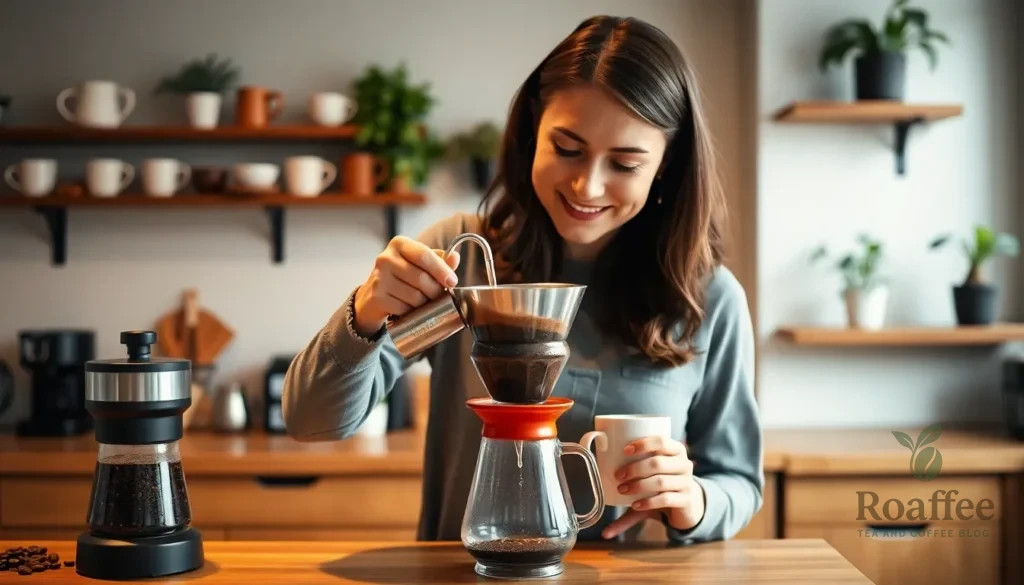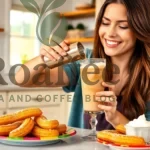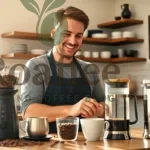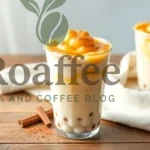We’ve all been there – standing in our kitchen at 6 AM desperately craving that perfect cup of coffee but settling for something that tastes more like bitter water than the rich brew we dream about. The truth is you don’t need expensive equipment or barista training to make exceptional coffee at home.
Great coffee starts with understanding the basics: quality beans fresh water and proper technique. We’ll show you how small changes in your brewing method can transform your morning routine from disappointing to delightful. Whether you’re using a simple drip machine French press or pour-over setup the principles remain the same.
The secret lies in the details – from the grind size to water temperature to brewing time. Once you master these fundamentals you’ll never have to settle for subpar coffee again. Let’s jump into the simple steps that’ll have you brewing café-quality coffee in your own kitchen every single morning.
Equipment and Tools Needed
The right equipment forms the foundation of exceptional home coffee brewing. We believe that investing in quality tools will transform your daily coffee ritual and deliver consistently superior results.
Essential Coffee Brewing Equipment
Coffee Grinder
We recommend a burr grinder as your most important investment. Burr grinders produce uniform particle sizes that extract flavors evenly. Blade grinders create inconsistent grounds that lead to bitter or weak coffee. A quality burr grinder costs between $50-200 and will last for years.
Brewing Device
Your brewing method determines the final flavor profile. French presses create full-bodied coffee with rich oils. Pour-over devices like V60 or Chemex produce clean bright flavors. Drip machines offer convenience for daily brewing. Each method requires different grind sizes and brewing times.
Digital Scale
Precision matters when brewing excellent coffee. We use a digital scale to measure both coffee and water accurately. The golden ratio is 1:15 to 1:17 (coffee to water). A scale eliminates guesswork and ensures repeatable results every time.
Kettle
Water temperature affects extraction significantly. We need water between 195-205°F for optimal brewing. A kettle with temperature control prevents overheating that burns coffee grounds. Gooseneck kettles provide precise pouring control for pour-over methods.
Quality Water
Filtered water improves coffee taste dramatically. Tap water often contains chlorine and minerals that interfere with extraction. We recommend using filtered or bottled water with balanced mineral content for the best results.
Optional but Helpful Tools
Coffee Timer
Timing controls extraction strength and prevents over-brewing. We use timers to track steeping times for different brewing methods. French press requires 4 minutes while pour-over takes 2-4 minutes depending on grind size.
Thermometer
Temperature consistency creates better coffee. We measure water temperature to stay within the optimal range. Digital thermometers provide instant readings and help develop muscle memory for proper temperatures.
Storage Containers
Airtight containers preserve coffee freshness longer. We store beans in opaque containers away from light and heat. Vacuum-sealed containers maintain flavor for weeks after opening.
Cleaning Supplies
Regular cleaning prevents oil buildup that creates bitter flavors. We use specialized coffee cleaners for equipment maintenance. Simple soap and water work for daily cleaning of most brewing tools.
Ingredients
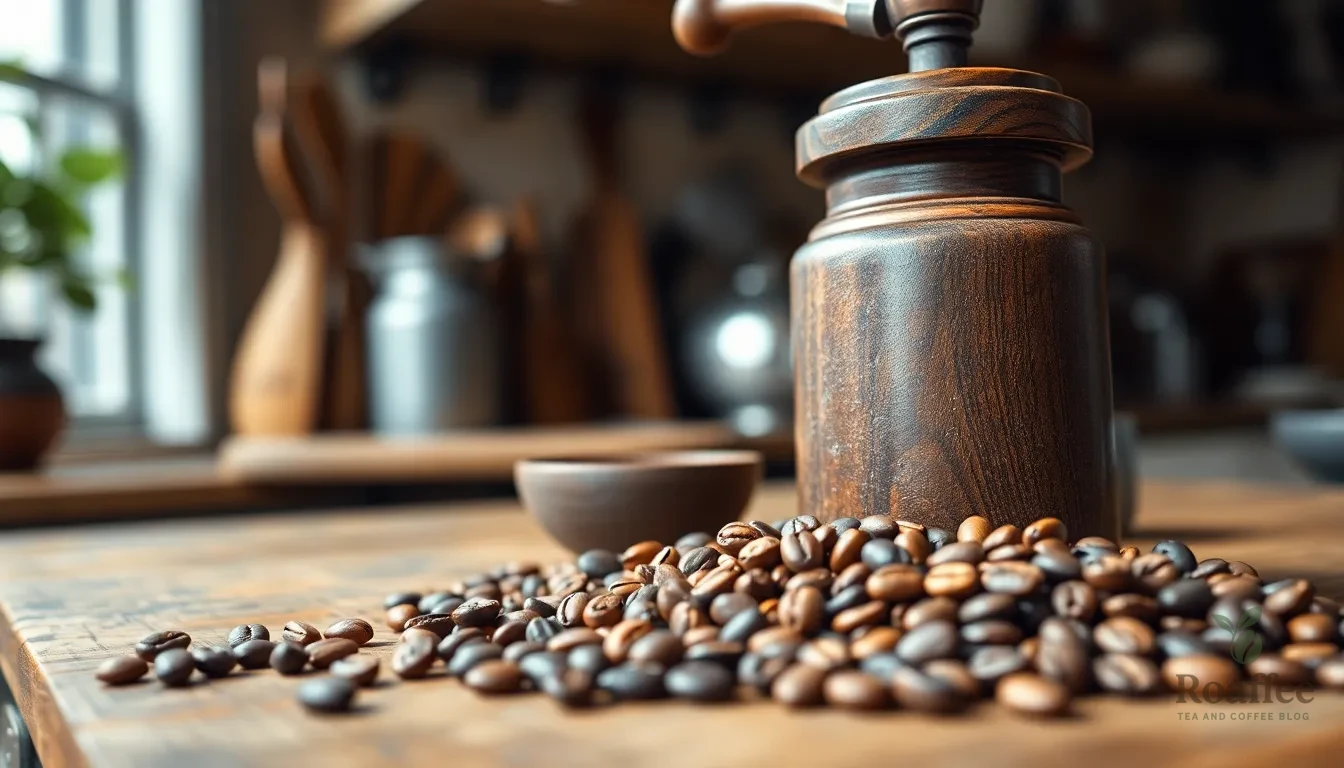
Quality ingredients form the foundation of exceptional home coffee brewing. We focus on three essential components that directly impact your coffee’s flavor and overall experience.
Coffee Beans
We recommend using fresh, high-quality coffee beans that have been recently roasted and ground just before brewing to preserve their natural flavor and aroma. The grind size plays a crucial role in extraction and depends entirely on your chosen brewing method.
- Pour-over brewing: Use a grind size similar to table salt for small cones or kosher salt for larger brewers like Chemex
- French press: Use a coarse grind resembling sea salt
- Espresso: Use a very fine grind that appears almost powdery
A burr grinder delivers the most consistent grind size, which ensures optimal extraction across all brewing methods. We always grind beans immediately before brewing to maintain peak freshness and flavor intensity.
Water Quality
Clean, filtered water with minimal minerals prevents unwanted flavors from altering your coffee’s taste profile. We avoid re-boiling water and instead heat fresh water to the ideal brewing temperature.
The optimal water temperature ranges between 196°F and 205°F (91°C to 96°C) for proper flavor extraction without introducing bitterness. After boiling, we let the water cool for approximately 30 seconds before pouring over the coffee grounds.
| Water Parameter | Ideal Range |
|---|---|
| Temperature | 196°F – 205°F |
| pH Level | Around 7 (neutral) |
| Mineral Content | Minimal |
Water with a neutral pH level around 7 enhances flavor extraction while preventing off-tastes that can compromise your coffee’s quality.
Additional Ingredients
While not essential for the brewing process, additional ingredients can enhance or balance your coffee’s natural flavors based on personal preference. We can enjoy coffee black to experience its pure taste or customize it with various additions.
- Milk or cream for richness and smoothness
- Sugar or sweeteners for balanced sweetness
- Spices like cinnamon or vanilla for flavor complexity
- Alternative milk options for dietary preferences
These ingredients allow us to personalize our coffee experience while maintaining the quality foundation established through proper beans and water selection.
Prep

Proper preparation forms the foundation of exceptional home coffee brewing. We’ll guide you through three critical preparation steps that determine your coffee’s final quality.
Selecting the Right Coffee Beans
We recommend starting with fresh, high-quality whole beans that match your taste preferences. Whole beans maintain their freshness significantly longer than pre-ground coffee, preserving the essential oils and flavors that create a superior cup. Store your beans in an airtight container away from light and heat to prevent degradation.
Choose beans roasted within two weeks of your brewing date for optimal flavor extraction. Light roasts offer bright, acidic notes while dark roasts provide bold, robust flavors. Medium roasts balance both characteristics, making them ideal for beginners exploring different taste profiles.
Grinding Your Coffee
Grind size directly impacts your coffee’s extraction and final taste. We match our grind size to our exact brewing method for consistent results:
| Brewing Method | Grind Size | Description |
|---|---|---|
| French Press | Coarse | Like sea salt |
| Chemex | Medium-coarse | Slightly finer than sea salt |
| Pour-over cones | Fine | Like table salt |
| Espresso | Fine | Like table salt |
Use a burr grinder rather than a blade grinder for consistent particle size. Burr grinders ensure even extraction by producing uniform coffee grounds, while blade grinders create uneven particles that lead to over-extraction and bitter flavors.
Measuring Coffee and Water Ratios
Precision in measuring creates consistent, delicious coffee every time. We follow the golden coffee-to-water ratio of 1:16 to 1:18, meaning 1 gram of coffee for every 16-18 grams of water.
| Coffee Style | Ratio | Description |
|---|---|---|
| Drip Coffee | 1:16 | Stronger, more concentrated |
| Balanced Cup | 1:17 | Well-rounded flavor |
| Lighter Cup | 1:18 | Milder, less intense |
Use a kitchen scale to measure both coffee and water precisely. Avoid using tablespoons or volume measurements, as they lack the accuracy needed for consistent brewing. Weighing your ingredients ensures reproducible results and helps you adjust ratios according to your taste preferences.
Instructions
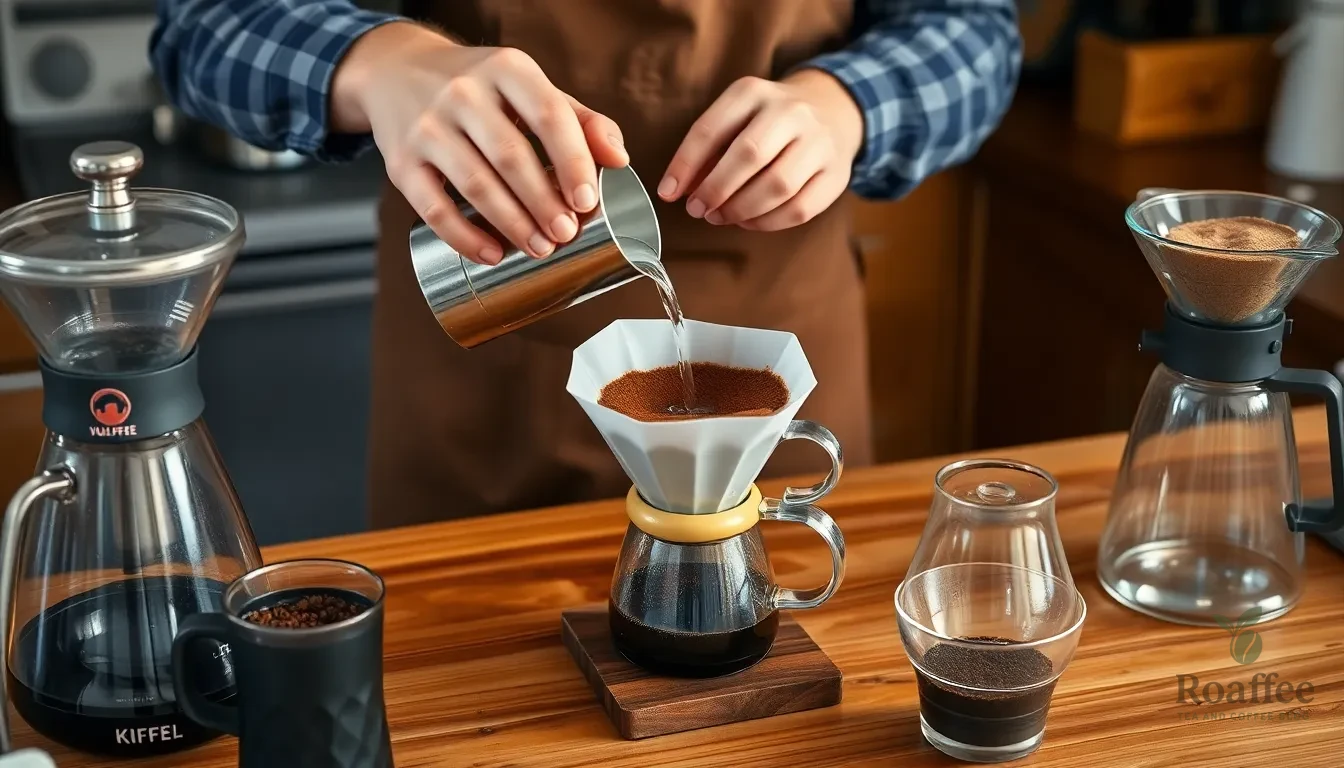
Now that we’ve prepared our ingredients and equipment, let’s jump into the step-by-step brewing process. Each method offers unique advantages for creating exceptional coffee at home.
Method 1: Pour Over Coffee
We’ll start with the pour over method, which delivers clean flavors and allows precise control over extraction.
- Set up your equipment: Place a paper filter in your V60, Chemex, or Kalita Wave cone. Position it over your cup or carafe.
- Pre-wet the filter: Pour hot water through the empty filter to remove papery taste and warm your brewing vessel. Discard this water.
- Add coffee grounds: Use 12-30g of medium-fine coffee grounds (similar to table salt for small cones, or medium-coarse like kosher salt for larger brewers). Create a small well in the center.
- Bloom the coffee: Pour twice the weight of coffee in water over the grounds. For 30g of coffee, use 60g of water. Wait 30-45 seconds as gases escape and the coffee “blooms.”
- Continue pouring: Add water slowly in circular motions, maintaining even saturation. Use a 16:1 water-to-coffee ratio for optimal extraction.
- Finish brewing: Swirl gently to ensure uniform extraction. Total brew time should be 4-6 minutes for best results.
Method 2: French Press Coffee
French press brewing produces full-bodied coffee with rich oils and deeper flavors.
- Heat water: Bring water to a boil, then let it cool slightly (especially important for dark roasts).
- Add coffee grounds: Use coarse grounds resembling sea salt or steel-cut oats. Add 60-70g of coffee per liter of water for optimal strength.
- Combine and stir: Pour hot water over grounds, ensuring complete saturation. Stir gently to mix thoroughly.
- Steep: Place the lid on your French press with the plunger up. Let coffee steep for 4-5 minutes.
- Press and serve: Slowly push the plunger down with steady pressure. Serve immediately to prevent over-extraction.
Method 3: Drip Coffee Maker
Drip coffee makers offer convenience for brewing multiple cups with consistent results.
- Prepare the machine: Add a paper filter to the basket and rinse if desired.
- Add coffee: Use medium grind coffee similar to granulated sugar. Follow your preferred coffee-to-water ratio.
- Fill with water: Use clean, cold filtered water for best flavor extraction.
- Start brewing: Turn on the machine and let it complete the automatic brewing cycle.
- Serve fresh: Pour coffee immediately after brewing for optimal taste and temperature.
Method 4: Espresso-Style Coffee
Espresso brewing creates concentrated, intense coffee with rich crema through high-pressure extraction.
- Grind finely: Use coffee ground to a fine consistency, almost powder-like.
- Dose and tamp: Add grounds to the portafilter and tamp evenly with firm pressure.
- Extract shot: Use an espresso machine to force hot water through grounds at ~9 bars of pressure.
- Time extraction: Aim for 25-30 seconds total extraction time for balanced flavor.
- Serve immediately: Pour the shot directly into your cup to preserve the crema and optimal temperature.
| Brewing Method | Grind Size | Water Temperature | Brew Time | Coffee-to-Water Ratio |
|---|---|---|---|---|
| Pour Over | Medium-fine to medium-coarse | 196°F-205°F | 4-6 minutes | 1:16 |
| French Press | Coarse | 196°F-205°F | 4-5 minutes | 1:16 |
| Drip Coffee | Medium | 196°F-205°F | 5-6 minutes | 1:15-1:17 |
| Espresso | Fine | 190°F-196°F | 25-30 seconds | 1:2 |
Directions for Perfect Brewing
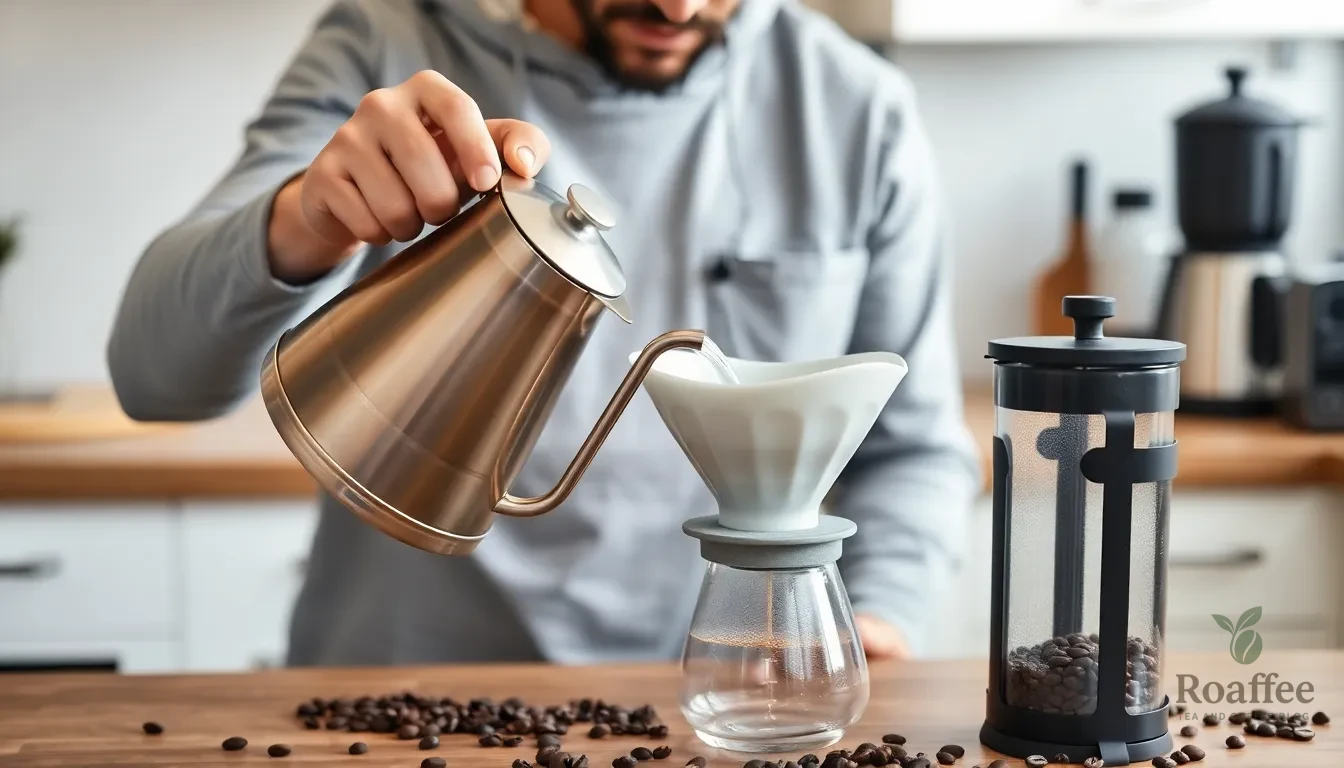
Now that we’ve covered the fundamentals of coffee preparation, let’s focus on the precise techniques that will elevate your home brewing to professional standards. These three critical aspects of the brewing process will ensure consistent, flavorful results every time.
Water Temperature Guidelines
Getting the water temperature right is essential for proper extraction and balanced flavor in your coffee. We recommend heating water to 195-205°F (90-96°C) for most brewing methods, particularly pour-over and drip coffee.
The simplest approach is to bring water to a full boil, then let it cool for 30-60 seconds to reach the optimal temperature range. This cooling period allows you to achieve the perfect brewing temperature without needing a thermometer.
For French press brewing, we suggest preheating the carafe with hot water before adding your coffee grounds. This technique helps maintain a stable brewing temperature throughout the 4-5 minute steeping process, ensuring consistent extraction.
Timing Your Brew
Proper timing varies significantly based on your chosen brewing method, and understanding these differences is crucial for optimal results. Full immersion methods like French press require 4-5 minutes of steeping time to achieve the rich, full-bodied flavor we’re seeking.
Pour-over methods typically take a few minutes to complete as water filters through the grounds, but the exact timing depends on your grind size and pouring technique. We recommend starting with these baseline times and adjusting based on your taste preferences.
Remember that longer extraction times increase both strength and potential bitterness, so finding the sweet spot for your palate may require some experimentation. Start with recommended times and adjust in 30-second increments until you achieve your desired flavor profile.
Pouring Techniques
Mastering your pouring technique is especially important for pour-over methods, where water distribution directly impacts flavor extraction. We recommend pouring water slowly and evenly in a circular motion to ensure all grounds are saturated uniformly.
Using a pour-over kettle with a narrow spout gives you precise control over flow rate, which is essential for consistent results. This controlled pouring allows for proper blooming and even extraction throughout the brewing process.
Consistency in both pouring speed and water distribution is the key to extracting balanced flavors from your coffee grounds. Focus on maintaining steady, controlled movements rather than rushing through the process, as this patience will be rewarded with superior taste in your final cup.
Make-Ahead Tips
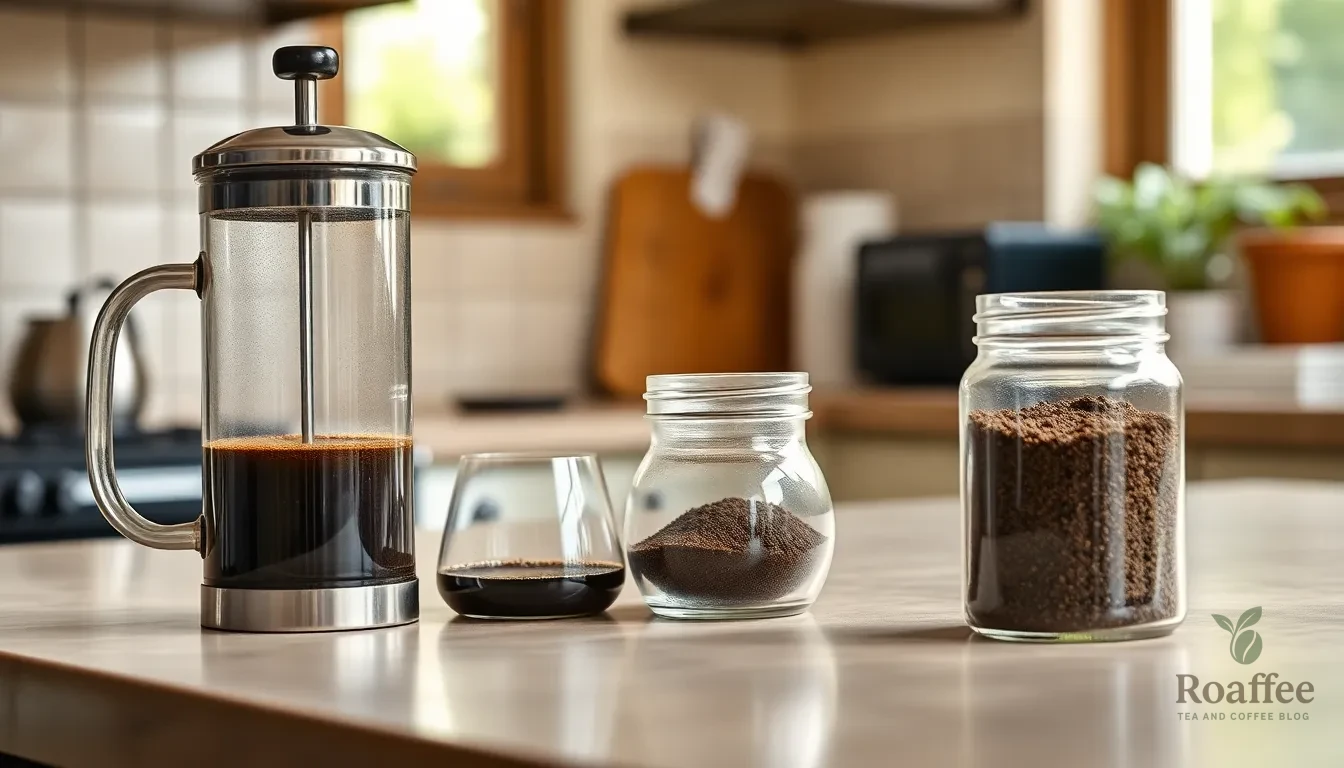
We understand that morning routines can be hectic and preparing coffee ahead of time can streamline your daily brewing process. These strategies help maintain coffee quality while saving precious time during busy mornings.
Preparing Coffee the Night Before
Cold brew offers the most successful make-ahead option for coffee preparation. We recommend steeping coarse grounds in cold water for 12-24 hours to create a smooth concentrate that maintains excellent flavor when stored properly in the refrigerator.
Regular hot-brewed coffee loses its optimal taste quickly when prepared in advance. But, you can set up your brewing equipment the night before by measuring out your coffee grounds and water. This preparation method allows you to start brewing immediately upon waking without compromising the fresh taste that comes from immediate brewing.
French press enthusiasts can benefit from grinding their beans and measuring portions the evening before. Store the measured grounds in an airtight container overnight and combine with hot water in the morning for the full 3-4 minute steeping process.
Storing Ground Coffee
Ground coffee requires careful storage to preserve its aromatic compounds and prevent flavor degradation. We recommend using airtight containers made of glass or ceramic to protect grounds from exposure to air and moisture.
Keep your ground coffee containers away from heat sources like stovetops or direct sunlight. Room temperature storage in a dark pantry or cabinet works best for maintaining freshness over several days.
Moisture poses the greatest threat to ground coffee quality. Avoid storing containers in refrigerators or freezers where condensation can occur. Instead, choose a dry location with stable temperature conditions.
Light exposure accelerates the breakdown of coffee’s complex flavor compounds. Dark containers or opaque storage vessels help shield grounds from harmful UV rays that can create bitter or stale flavors.
Ground coffee maintains peak freshness for only 7-10 days after grinding. We suggest grinding smaller batches more frequently rather than preparing large quantities that may lose their vibrant taste before use.
Serving Suggestions
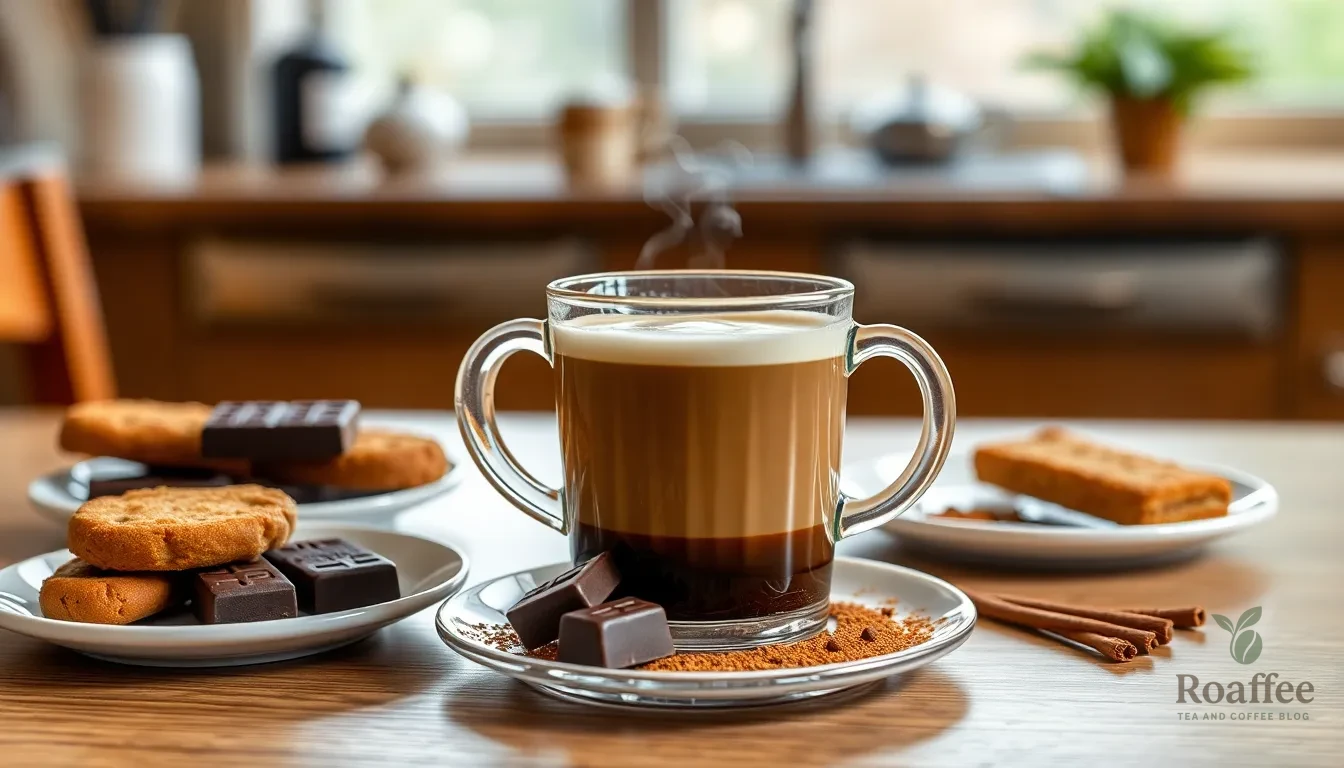
Now that we’ve brewed our perfect cup of coffee, let’s explore ways to enhance and present it beautifully. The right additions and presentation can transform our home-brewed coffee into a café-quality experience.
Coffee Additions and Enhancements
We recommend starting with dairy additions to create a smoother texture and mellower flavor profile. Milk, cream, or plant-based alternatives like oat milk or almond milk work wonderfully to balance the coffee’s natural acidity. Each option brings its own unique character to the brew.
Sweeteners offer another layer of customization for our coffee experience. Sugar dissolves quickly and provides clean sweetness, while honey adds floral notes and complexity. Flavored syrups open up endless possibilities, from classic vanilla to seasonal favorites like caramel or pumpkin spice.
Spice additions can elevate our coffee’s aroma and flavor significantly. We suggest adding a pinch of cinnamon directly to the grounds before brewing, or sprinkling nutmeg on top of the finished cup. These warm spices complement coffee’s natural notes beautifully.
Flavored creamers provide convenience and variety for busy mornings. We can also experiment with a small pinch of salt, which surprisingly reduces bitterness and enhances the coffee’s natural sweetness. This technique works particularly well with darker roasts.
Presentation Tips
Serving our coffee in a pre-warmed cup maintains the optimal temperature longer. We recommend rinsing cups with hot water before pouring to prevent the coffee from cooling too quickly upon contact with cold ceramic or glass.
Clean, clear cups showcase our coffee’s rich color and create visual appeal. The transparency allows us to appreciate the coffee’s depth and any artistic milk additions we might create. Glass mugs work especially well for displaying layered drinks.
Garnishing adds a professional touch to our home-brewed coffee. We can place a cinnamon stick as a stirrer for both function and fragrance, or create an attractive swirl of cream on the surface. These small details make the coffee experience more memorable.
Accompaniments complete the café-like atmosphere we’re creating at home. We suggest presenting our coffee with a small biscotti, chocolate square, or pastry on the side. This pairing enhances the overall sensory experience and makes even our everyday coffee feel special.
Storage and Maintenance
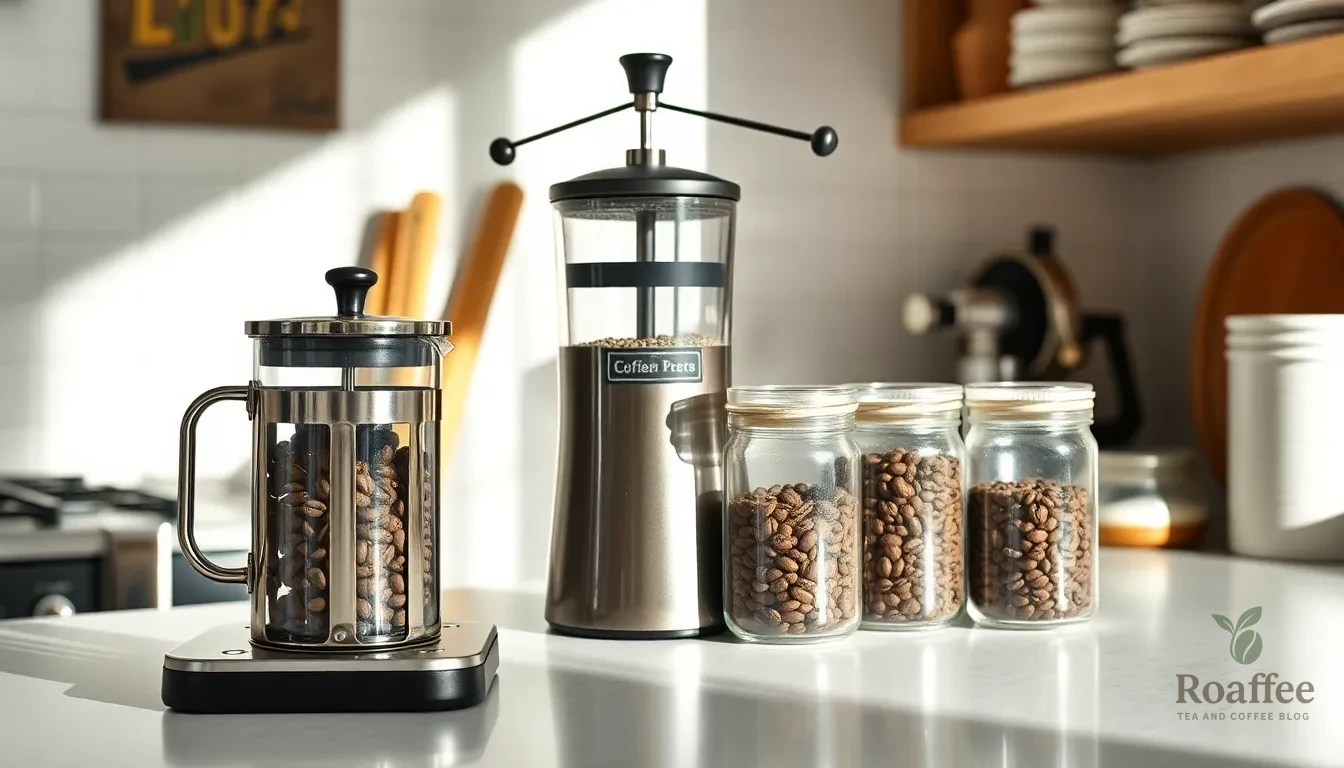
Proper storage and maintenance practices ensure your coffee brewing equipment performs optimally and your beans retain their peak flavor. We’ll cover essential cleaning routines and storage techniques that preserve coffee freshness and prevent equipment from affecting taste.
Keeping Your Equipment Clean
Regular cleaning prevents buildup that can alter your coffee’s flavor and compromise the brewing process. We recommend washing your coffee maker and grinder thoroughly after each use to remove oils and residue that accumulate over time.
Coffee oils become rancid when left on equipment surfaces and create bitter or off-flavors in your brew. Clean your French press by disassembling all parts and washing them with warm soapy water. Pour-over equipment requires rinsing the dripper and replacing filters regularly to maintain optimal flow rates.
Grinders need special attention since coffee particles and oils can clog the burrs or blades. We suggest running a small amount of rice through blade grinders monthly to absorb oils and remove stuck particles. Burr grinders benefit from periodic disassembly and cleaning with a brush to remove accumulated grounds.
Deep cleaning should occur weekly for daily coffee drinkers. Run a vinegar solution through drip machines and thoroughly rinse afterward to remove mineral deposits. This maintenance routine extends equipment life and ensures consistent brewing performance.
Storing Coffee Beans Properly
Coffee freshness degrades rapidly when exposed to oxygen, moisture, heat, and light. We store our beans in airtight containers made of glass, ceramic with vacuum seals, or stainless steel to block these freshness enemies effectively.
Location matters significantly for preserving coffee quality. Keep your beans in a cool, dark place away from direct sunlight and heat sources like stoves or sunny countertops. Pantry shelves or dedicated coffee storage areas work best for maintaining stable temperatures.
Avoid frequent exposure to air by portioning coffee into smaller amounts rather than opening large containers repeatedly. We recommend buying beans in quantities you’ll consume within two weeks to ensure optimal freshness.
Freezing beans can preserve freshness when done correctly using truly airtight containers. But, avoid repeated thawing cycles that introduce moisture and degrade flavor compounds. Single-use freezer portions work better than repeatedly accessing frozen coffee.
| Storage Method | Container Type | Duration | Key Benefits |
|---|---|---|---|
| Room Temperature | Airtight glass/ceramic | 1-2 weeks | Easy access, maintains flavor |
| Pantry Storage | Vacuum-sealed containers | 2-3 weeks | Protected from light/heat |
| Freezer Storage | Airtight portions | 1-2 months | Extended freshness |
Proper storage preserves vibrant aroma and prevents the flat, stale taste that develops when coffee beans are exposed to air and moisture. These practices ensure every cup you brew maintains the complex flavors that make exceptional coffee at home possible.
Conclusion
Mastering the art of home coffee brewing isn’t about expensive equipment or complicated techniques. It’s about understanding the fundamentals and paying attention to the details that make the difference between ordinary and extraordinary coffee.
With the right beans proper storage and consistent brewing practices you’ll transform your morning routine into something truly special. Remember that every small adjustment—from grind size to water temperature—contributes to your perfect cup.
The journey to exceptional home-brewed coffee is one of experimentation and discovery. Start with these fundamentals and trust your taste buds as you fine-tune your technique. Soon you’ll be creating café-quality coffee that rivals your favorite coffee shop right in your own kitchen.
Frequently Asked Questions
What equipment do I need to make great coffee at home?
The essential equipment includes a quality burr grinder for uniform particle size, a brewing device (French press, pour-over, or drip machine), a digital scale for precise measurements, and filtered water. Optional but helpful tools include a timer and thermometer. You don’t need expensive equipment—focusing on these basics will significantly improve your coffee quality.
What’s the ideal coffee-to-water ratio for brewing?
The golden ratio for coffee brewing is 1:15 to 1:18, meaning 1 gram of coffee for every 15-18 grams of water. This translates to roughly 2 tablespoons of coffee per 6 ounces of water. Using a digital scale ensures consistency and helps you achieve the perfect strength for your taste preferences.
How does grind size affect coffee flavor?
Grind size directly impacts extraction and flavor. Coarse grinds (like sea salt) work best for French press, medium grinds (like table salt) for pour-over, and fine grinds for espresso. The wrong grind size can lead to over-extraction (bitter taste) or under-extraction (weak, sour taste).
What’s the optimal water temperature for brewing coffee?
The ideal water temperature for brewing coffee is between 195°F and 205°F (90°C to 96°C). Water that’s too hot can over-extract and create bitter flavors, while water that’s too cool won’t extract enough flavor compounds. Let boiling water sit for 30 seconds to reach the optimal temperature.
How long should I brew coffee using different methods?
Brewing times vary by method: French press requires 4-5 minutes of steeping, pour-over takes 3-4 minutes total, drip coffee machines typically take 4-6 minutes, and espresso extracts in 25-30 seconds. Proper timing ensures optimal extraction and prevents over-brewing that leads to bitter flavors.
Can I prepare coffee in advance for busy mornings?
Yes! Cold brew is the best make-ahead option, steeping for 12-24 hours and lasting up to a week refrigerated. For hot coffee, set up your equipment the night before. Store ground coffee in airtight containers and use within 7-10 days for best flavor.
How should I store coffee beans to maintain freshness?
Store whole coffee beans in an airtight container in a cool, dark place away from heat, moisture, and direct sunlight. Use beans within 2-4 weeks of the roast date for optimal flavor. Avoid storing coffee in the refrigerator, as it can absorb odors and moisture.
What’s the difference between various brewing methods?
Each method produces different flavor profiles: French press creates full-bodied coffee with oils and sediment, pour-over produces clean, bright flavors, drip machines offer convenience and consistency, and espresso creates concentrated, intense coffee. Choose based on your taste preferences and lifestyle needs.
How often should I clean my coffee equipment?
Clean your coffee maker and grinder after each use to prevent oil buildup that can create bitter flavors. Deep clean weekly with descaling solutions for machines and thorough washing for manual equipment. Regular maintenance ensures consistent flavor and extends equipment lifespan.
What type of water should I use for brewing coffee?
Use filtered water with a neutral pH level for optimal flavor extraction. Tap water with high mineral content or chlorine can negatively impact taste. The water should be clean and fresh, as coffee is 98% water, making water quality crucial for exceptional results.

